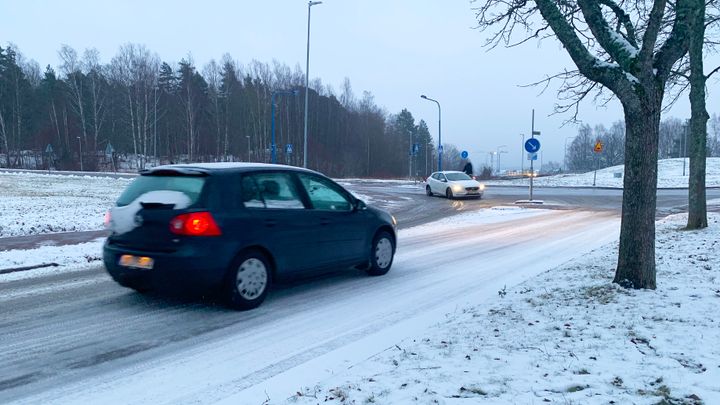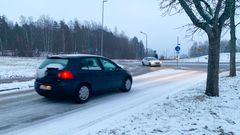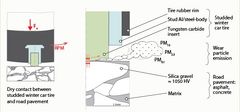Alternative to studded winter tires reduces airborne particles by 20 percent
On icy roads, studded winter tires can save lives – but they pulverize pavement and fill the air with dangerous, inhalable particles. A new Swedish study shows that both road wear and airborne particles could be reduced by as much as 20 percent if studs were made instead with an alternative hard metal.

• Two stud materials were evaluated in two dedicated test rigs for road wear and airborne particle emission studies.
• One of the stud materials was a cobalt containing stud and the other one was a cobalt free alternative.
• Lower particle emissions and road wear for the cobalt free stud compared to today’s standard cobalt containing one.
In tests at KTH Royal Institute of Technology in Stockholm, researchers compared asphalt wear-and-tear and particle emissions caused by cobalt-containing studs with studs composed of an alternative, iron-nickel containing hard metal. They found that the iron-nickel stud material could grip ice and packed snow just as well—while causing significantly less damage to the road surface.
“Cobalt is a cheap solution,” says Ulf Olofsson, a professor in the Department of Engineering Design at KTH Royal Institute of Technology. “It’s so hard that it doesn’t wear down, which is why it’s also mass produced for rock drilling tools.”
“But asphalt is soft enough that cobalt-containing studs grind and pulverize it into ultra-fine particles that go deep down into the body when inhaled.”
Studs need to be only 20 to 30 percent harder than asphalt to make driving on ice safer, Olofsson says. “But the studs on the market today are double the hardness of road material and nine times the hardness of glacial ice at -40C.
“That’s overkill,” he says.
Olofsson says the research team is now studying the longevity of alternative stud materials – the next step in finding an alternative to cobalt-containing studs.
Though studies show studded tires save roughly 70 lives each year in Sweden, some cities in the country have banned them on designated roadways due to the health risk posed by airborne asphalt particles. In most U.S. states, use of studded tires is restricted, while several states have banned them altogether. Mostly allowed across Europe, the tires are however banned in several, including Germany, the Netherlands and Poland.
In the EU, non-exhaust vehicle emissions from tire, road and brake wear are equivalent to exhaust emissions in terms of PM10 (particles with aerodynamic diameters smaller than 10 µm), Olofsson says. But in the Nordic countries, non-exhaust PM10 emissions significantly exceed those from exhaust due to the frequent use of studded tires.
It also increases road maintenance costs for the public. He estimates that Swedish road surfaces have a lifespan half as long as the roads in Germany, where a ban on studded tires is in place.
Images


Subscribe to releases from KTH Royal Institute of Technology
Subscribe to all the latest releases from KTH Royal Institute of Technology by registering your e-mail address below. You can unsubscribe at any time.
Latest releases from KTH Royal Institute of Technology
For graphene production, a potential green alternative to mining graphite3.3.2025 14:14:40 CET | Press Release
Researchers in Sweden report a green alternative to reduce reliance on mining graphite, the raw source behind the "wonder material" graphene.
AI on aircraft can help prevent stalls and terrifying drops in altitude17.2.2025 15:58:14 CET | Press Release
Artificial intelligence could help prevent terrifying mid-air drops in altitude. In a new study, an international research team successfully tested a machine learning system for preventing trouble with turbulence.
As Scandinavian peninsula rises from sea, new satellite data shows gravity changes6.2.2025 09:15:25 CET | Press Release
Bouncing back from under the weight of Ice Age glaciers which have long since vanished, the Nordic region land mass is slowly rising above sea level. Two scientists at Sweden’s KTH Royal Institute of Technology have a refined a method for measuring and predicting the small details of how this slow movement changes Earth’s gravitational pull over time. One thing they found is that the Fennoscandinavian peninsula's land mass is more dense than previously known.
Study on ship sliming may enable reduced costs and emissions in ocean transport21.1.2025 11:25:01 CET | Press Release
Slime build-up is a costly drag on fuel efficiency for ocean-going cargo ships, leading to more emissions and, eventually, higher consumer prices. A recent study, however, suggests a new approach to managing this common problem.
To compete globally, Europe’s seafood farmers may get boost from AI research14.11.2024 13:30:27 CET | News
Underwater drones adapted to cold Nordic waters, and sensors that listen to the sounds of fish eating. These are some of the AI solutions that could give European sea farmers a boost to compete globally. Researcher Fredrik Gröndahl explains how maching learning is being developed take on operational challenges and reduce costs in aquaculture, particularly in inaccessible waters far offshore.
In our pressroom you can read all our latest releases, find our press contacts, images, documents and other relevant information about us.
Visit our pressroom